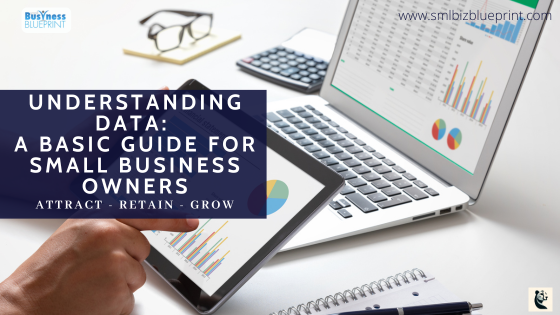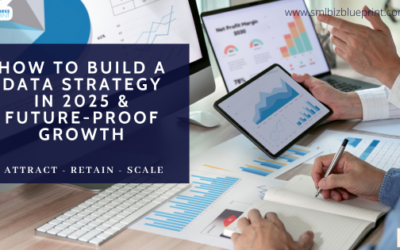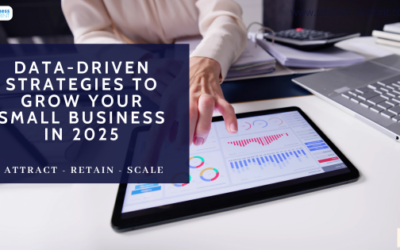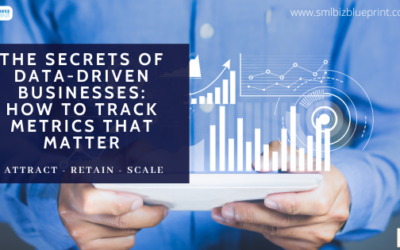As a small business owner, you might hear much about data and its importance in business.
You may think data is only relevant for large companies, but that’s false. Data can be a powerful tool for businesses of all sizes.
This blog post will explain data, why it’s crucial for your business, and what the discussions around AI and LLM (Large Language Models) mean for you.
Data is simply information that you collect and use to make decisions. It can be numbers, descriptions, or even customer feedback.
By understanding and using data effectively, you can make better decisions, improve efficiency, and enhance customer satisfaction.
Let’s dive into the data types relevant to your business and how you can leverage them.

#1 What is Data?
Data is any information that can be collected, stored, and analysed.
For small businesses, data can come in many forms, including:
Sales Data: This includes information about revenue, units sold, and transaction volumes. It helps you understand what products perform well and identify trends over time.
Stock Data: This includes details about your inventory levels, turnover rates, and restocking times. It ensures you maintain optimal inventory levels, avoiding both stockouts and overstock situations.
Customer Data: This includes demographics, behaviour, and customer feedback. It helps you understand your customers, what they buy, and their preferences.
Employee Data: This includes your staff’s productivity, attendance, and performance reviews. It helps you identify top performers and areas for training.
Digital Data: Tools like Google Analytics provide in-depth data on your website traffic and user behaviour. Understanding metrics such as page views, bounce rates, and conversion rates can help you optimise your website for better user experience and higher conversions.
By collecting and analysing these types of data, you can make informed decisions that enhance your business operations.
#2 Why Data is Important for Your Business
Sales:
Tracking Performance: Sales data is crucial for understanding how well your products are performing. You can identify best-selling products, peak selling periods, and underperforming items by tracking sales data.
For example, if you notice a particular product sells exceptionally well during the holiday season, you can stock more of it in advance.
Forecasting: Accurate sales forecasting helps you plan for the future. You can predict future sales and prepare accordingly by analysing past sales data. This helps in managing inventory, staffing, and marketing efforts.
For instance, if your sales data indicates a surge in demand during summer, you can ensure you have enough stock and staff to handle it.
Stock Management:
Inventory Levels: Managing inventory efficiently is crucial for any business. Data helps you keep track of stock levels, ensuring you don’t run out of popular items or overstock on slow-moving products.
Tools like automated inventory systems can alert you when stock levels are low so you can reorder in time.
Supplier Performance: Monitoring supplier performance is essential to ensuring timely deliveries and quality products. You can evaluate and select the best suppliers by tracking metrics such as delivery times, order accuracy, and costs.
For example, if a supplier consistently delivers late, you can negotiate better terms or switch to a more reliable one.
Digital Marketing:
Campaign Effectiveness: Data allows you to measure the effectiveness of your marketing campaigns. Key metrics like click-through rates, conversion rates, and customer acquisition costs help you understand what works and what doesn’t.
For instance, you might need to improve your call-to-action if an email campaign has a high open rate but low conversions.
Customer Insights: Collecting and analysing customer data provides valuable insights into their preferences and behaviour. This helps you create personalised marketing strategies that resonate with your audience.
For example, segmenting your customers based on purchase behaviour allows you to target them with relevant promotions.
Website Analytics: Tools like Google Analytics provide in-depth data on your website traffic and user behaviour. Understanding metrics such as page views, bounce rates, and conversion rates can help you optimise your website for better user experience and higher conversions.
For instance, if Google Analytics shows high bounce rates on a particular page, you can investigate and improve the content or layout to retain visitors.
Customer Relations:
Customer Satisfaction: Feedback and reviews are essential for understanding customer satisfaction. Analysing this data helps you identify areas for improvement and enhance your products or services.
For instance, if customers frequently mention a specific issue in reviews, you can address it to improve satisfaction.
Retention Rates: Tracking customer retention is crucial for long-term success. Data helps you identify how many customers return and why they stay loyal. Developing strategies based on this data, such as loyalty programs or personalised offers, can improve retention rates.
Staff Management:
Performance Metrics: Monitoring employee performance data helps you identify top performers and areas where training is needed.
Metrics like productivity, attendance, and performance reviews provide a clear picture of your team’s strengths and weaknesses.
For example, rewarding high-performing employees can boost morale and productivity.
Workforce Planning: Using data for workforce planning ensures you have the correct number of staff at the right times.
Analysing staffing levels, shift patterns, and labour costs helps you optimise schedules.
For instance, adjusting staffing levels during peak business hours ensures you meet customer demand efficiently.

#3 Data Privacy and Security
Protecting your data and ensuring privacy is paramount, especially with increasing concerns about data breaches and regulations.
Here’s what you need to know:
Importance of Data Privacy:
Safeguarding customer and business data helps maintain trust and complies with legal requirements. Data breaches can lead to financial losses, reputational damage, and legal penalties.
Regulations:
Be aware of data privacy regulations such as GDPR (General Data Protection Regulation) and CCPA (California Consumer Privacy Act). These regulations require businesses to protect personal data and give individuals rights over their data.
Best Practices:
Data Encryption: Use encryption to protect data both in transit and at rest.
Access Control: Limit access to data based on roles and ensure only authorised personnel can access sensitive information.
Regular Audits: Conduct regular audits to identify vulnerabilities and ensure compliance with data protection policies.
Employee Training: Educate employees about data privacy and security best practices to prevent accidental breaches.
Data Minimization: Collect only the data you need, store it securely, and delete it when no longer necessary.
#4 What AI and LLM Models Mean for Your Data
AI (Artificial Intelligence) and LLM (Large Language Models) are technologies that can make your data even more powerful.
Here’s a basic rundown:
AI
This technology can learn from data and make decisions or predictions.
AI can help you predict which products will sell best during certain times of the year, optimise pricing strategies, and even automate customer service through chatbots.
LLM
These advanced AI models understand and generate human language. They can analyse large amounts of text data, like customer reviews or social media posts, to provide insights.
For instance, an LLM can help you understand common customer complaints and improve your products or services accordingly.
How This Applies to Small Businesses
You might think these technologies are only for big companies, but that’s untrue.
Here are some ways small businesses can use AI and LLM models:
Chatbots: Use AI-powered chatbots on your website to answer customer questions instantly. This improves customer service and frees up time for your staff to handle more complex inquiries.
Customer Feedback Analysis: AI and LLM models can analyse large volumes of customer feedback, identifying trends and insights that might be missed manually. This helps you make informed decisions to improve your products and services.
Personalised Marketing: AI can help you create customised marketing campaigns that target specific customer preferences. AI can recommend products, tailor promotions, and increase customer engagement by analysing customer data.
Conclusion
Data isn’t just for large companies; it’s a valuable resource for small businesses too. By understanding and using your data effectively, you can make better decisions, improve efficiency, and enhance customer satisfaction.
Embracing new technologies like AI and LLM models can further enhance your ability to leverage data, giving you a competitive edge.
Here’s how to get started:
- Begin Collecting Data: Start with the data you already have, such as sales and customer feedback. Use tools like Google Analytics for digital data.
- Choose the Right Tools: Invest in software for inventory management, CRM, and digital marketing analytics.
- Set Up Basic Reports: Create simple reports to track key metrics and identify trends.
- Prioritise Data Privacy: Implement best practices for data privacy and security to protect your customers and comply with regulations.
Future Trends to Watch:
Stay informed about emerging trends in data analytics and AI, such as predictive analytics and machine learning, to continuously improve your data strategy.
By following these steps, you can harness the power of data to drive your business forward.
Are you ready to take the next step?
Begin leveraging your data today and see the difference it makes!
FAQs
Q1. What is data analytics, and why is it important for small businesses?
A1: Data analytics involves collecting and analysing data to make informed business decisions. For small businesses, it helps them understand customer behaviour, optimise operations, and increase efficiency.
Q2. How can workflow automation benefit my small business?
A2: Workflow automation can streamline repetitive tasks, reduce errors, and save time. It allows employees to focus on higher-value activities, increasing productivity and cost savings.
Q3. What tools can help my small business with data management?
A3: Tools like Google Analytics, CRM software, and inventory management systems can help you collect, analyse, and leverage data effectively. They provide insights into customer behaviour, sales trends, and operational efficiency.
Q4. How do AI and LLM models apply to small businesses?
A4: AI and LLM models can automate customer service, analyse customer feedback, and personalise marketing campaigns. These technologies help small businesses improve efficiency and customer satisfaction.
Q5. What are the best practices for ensuring data privacy and security?
A5: To ensure data privacy and security, use data encryption, limit access to sensitive information, conduct regular audits, train employees on data protection, and comply with regulations like GDPR and CCPA.
Q6. How can I start using data analytics in my small business?
A6: Collect data from your current operations, such as sales and customer feedback. Use tools like Google Analytics to gather digital data and set up basic reports to track key metrics.
Q7. How can I measure the success of data-driven strategies in my business?
A7: Track sales growth, customer retention rates, and operational efficiency before and after implementing data-driven strategies. Use these metrics to assess the impact and make necessary adjustments.
Other Articles
Unlock Big Results: 5 Simple CRO Strategies for Small Businesses
Mastering Lead Scoring: Best Practices and Strategies for Small Business Success




